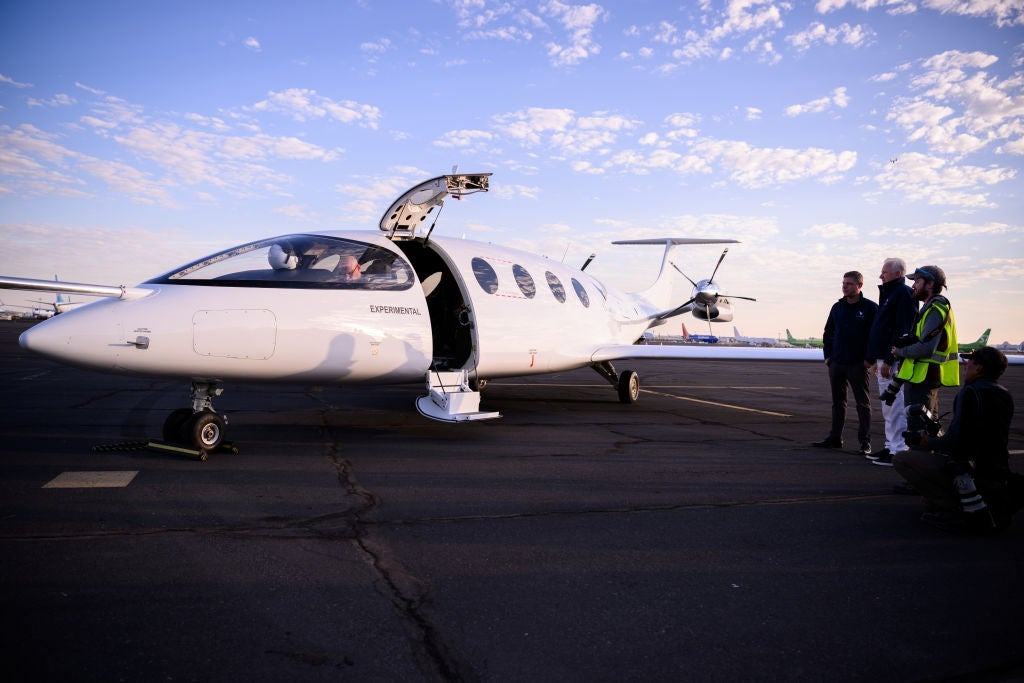Feature
How electric planes will revolutionise regional travel
Justin Gerdes argues that electrification will unlock the potential of small airports, decarbonise regional transportation and transform rural airports into renewable energy hubs.

Eviation’s Alice, after its successful test flight on 27 September 2022 in Washington, US. Credit: Mathieu Lewis-Rolland/Getty Images
Alittle more than two miles from my home in Concord, California, sits Buchanan Field Airport. In its early days, the US Army used the airport to train pilots during the Second World War. Today, Buchanan Field mostly hosts small private planes, with the San Francisco Bay Area’s commercial air passenger service overwhelmingly concentrated at larger airports in nearby San Francisco, Oakland and San Jose.
But what if, rather than the large airlines forcing me to fly from one of those regional hubs, I could instead depart from Buchanan Field? Before the end of this decade, for trips within California and to neighbouring states, I should be able to leave my home and 15 minutes later board a zero-emission, all-electric plane to my destination.
“If electric aircraft were used in a more localised scenario, they have the potential to transform the U.S. transportation sector,” write the authors of a new study by the US National Renewable Energy Laboratory (NREL).
The economics of modern air travel herds travellers into mega-hubs, serviced by jumbo jets, which will be difficult to decarbonise in the few years remaining to get on track to achieve Paris Agreement targets.
According to the NREL, just 0.6% of US airports service 70% of domestic air travel. Economies of scale and concentration at hubs may be good for the airlines, but for passengers, it makes air travel a gruelling gauntlet of crowded concourses, delayed departures and packed planes.
The freedom of regional all-electric flight
For short-haul flights of up to 500 miles (804km), at least, relief is coming – and sooner than you think. Last year, British Columbia-based regional airline Harbour Air flight-tested an all-electric version of its standard combustion engine Beaver plane, which the airline had retrofitted with an electric motor and battery pack. Harbour Air plans to launch the second generation of its eBeaver next year.
In the US, Washington State-based start-up Eviation conducted the first test flight of its nine-seat, all-electric plane, the Alice, in September 2022.
The company’s order book is now valued at more than $4bn. Eviation is set to launch the cargo version of the Alice in 2024, “kicking off the commercialisation of electric aircraft within the short-haul aviation sector”, notes the NREL study.
Electric aircraft could serve rural communities with fewer noise impacts.
Because experts, including the NREL authors, expect electric aircraft to have “significantly lower fuel and operating costs” than conventional aircraft, smaller airports like Buchanan Field will soon be a much more convenient and cheaper option for air travellers than large airports.
“Rather than flying in a traditional hub-and-spoke scenario, with large concentrations of aircraft at large hubs, electric aircraft could connect smaller regional or local airports directly,” write the NREL researchers.
“At these smaller airports, electric aircraft could efficiently utilise shorter runways, and due to their quiet operation, electric aircraft could serve rural communities with fewer noise impacts.”
Buchanan Field is currently subject to noise restrictions that limit when, and what kind of, planes can take off or land at the airport because it is surrounded by residential neighbourhoods
Electric planes to create renewable energy hubs
The NREL study cautions that small airports will have to upgrade their grid infrastructure to accommodate even a handful of all-electric planes. The charging demand from just five flights per day was larger than the baseline electricity demand for all 162 airports modelled.
This challenge also presents an opportunity, however. The study found that on-site distributed energy resources (DERs) – solar PV arrays and battery energy storage systems – could easily blunt charging demand peaks.
Small airports could use solar arrays and batteries to accommodate charging peaks, to avoid costly demand charges and even to turn a profit.
“Airport land area was never a constraining factor in the buildout of PV,” the NREL researchers found.
“Often the PV buildout was less than 1% of available land at airports. Onsite DERs could be used to export energy back to the electric grid when not being used for aircraft charging. This has the potential to transform regional airports into energy hubs.”
Rapid innovation on the horizon
Two small California airports are examples of what is coming. In 2019, Slovenian electric aircraft manufacturer Pipistrel built the first charging station at a US airport at Compton/Woodley Airport in Los Angeles County.
Just before Christmas last year, a microgrid outfitted with 2.5MW of solar PV arrays and a 2.2MW, nine-megawatt-hour battery storage system began operating at Arcata-Eureka Airport in Humboldt County. The Redwood Coast Airport Microgrid feeds wholesale electricity into the grid and is ready to power the airport and an adjacent US Coast Guard facility if the surrounding grid goes down.
There will be turbulence ahead. Innovators like Harbour Air and Eviation are deep into an arduous, years-long regulatory process to certify the first generation of electric planes in a situation where, according to Harbour Air, “the technology has been outpacing the regulators”.
The technology has been outpacing the regulators.
States and the federal government must invest in infrastructure to help convert small airports into renewable energy hubs that can serve all-electric fleets. And electrifying regional air travel would not be as necessary if the US had managed to build a high-speed rail network like those in Europe and China.
Despite the obstacles, I am confident that before the end of the decade, I will be able to fly directly from Concord to some of my favourite harder-to-reach cities – Ashland and Bend in Oregon; San Luis Obispo and Eureka in California – via an all-electric plane taking off just a few miles from my front door.